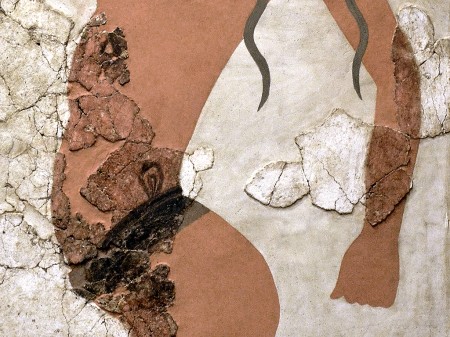Beth Stuart
DAMMA Paintings V1: Dependent Origination
17 October to 23 November 2019

Beth's been! for years now! feeling for a fulsome void, a robust lack, a burgeoning vacuity! She's been gnawing gently at the in-between here and there until her mouth might begin, if not to describe it, to pass the slimy-sweet peach pit centre that contains all the knowledge of the experience from her mouth to yours. Imagine then that the tree might germinate in your gut, and having done so, you might look at the thing made and know all that language can't explain about when and where and how and why. She feels this activity, this project, this practice - is an ethic, as well as an aesthetic. It goes on.
But we do like language. A void can feel a little scary. The raggy bag of our modernity says we still need to confirm that what we know is what we know.
These paintings are made from Venetian plaster and pigment. Venetian plaster is made from ground marble dust and lime. It has many of the same properties as what is used to make fresco. It comes to life when it is pushed, layered and polished. Heat and pressure turn it into something like stone again. It is not applied, it is layered and built to become again what it was before, but different.
The imagery, such as is decipherable, is loosely based on folkloric imagery of the outside ring of the Tibetan Buddhist Dharma Wheel. This outside wheel is called the cycle of Dependent Origination. This part of the wheel tells of the ways in which people turn away from the understanding that everything is interconnected; that the table is the wood is the tree is the seed. Beth is working with these ideas because, well, end times, neverending. If you see her, you could ask her more. She will tell you about the pictures they used, and why and how she changed them, and this would probably be a perfectly nice conversation, or an angry one, which could be welcomed equally.
The paintings also reference a mode of fresco restoration that Beth found, looking at images of the Akrotiri remnants in Santorini, Greece. Here, the frescos were buried after a volcanic eruption in the 16th century BC. When they made moves to open them to the public, instead of attempting any interpretive restoration, they sort of filled in the blanks with a flat, graphic version of what might have been there.
The then and the now, neatly ordered, but the now becoming every now; a dictated ubiquity. They tried to hand you the whole peach. Is it plastic? Will you be frozen in stone, with your hand outstretched, watching the peach rot to liquid?
Those particular frescos might tell interesting stories; about blue monkeys as messengers to the gods; about youth and economy, beauty and hierarchy; about saffron as a currency; about the collapse of a culture. About living at the foot of a rock that was once liquid and became a rock, and would become a liquid again. Here are pictures of things and people, old enough that we can dress them in our own outfits, to suit.
Back here, now, a mark follows another. Just paintings.
Cumulative things made of decisions about heres and theres and thens and nows. If you look at the work, and feel that you can't trace a straight line through these, consider the relationship of a straight line to a void. Remember the peach pit, and that she decided to eat the neverending ending, in order to share.
Cumulative things made of decisions about heres and theres and thens and nows. If you look at the work, and feel that you can't trace a straight line through these, consider the relationship of a straight line to a void. Remember the peach pit, and that she decided to eat the neverending ending, in order to share.

